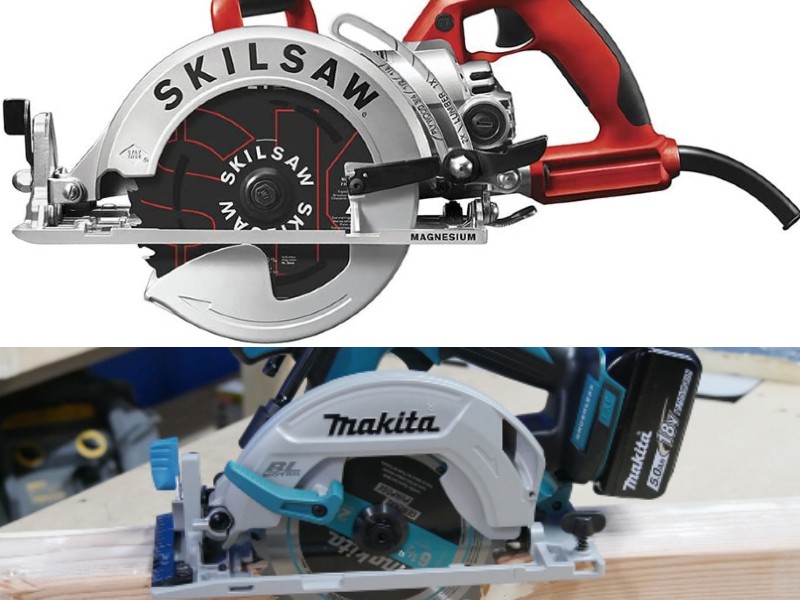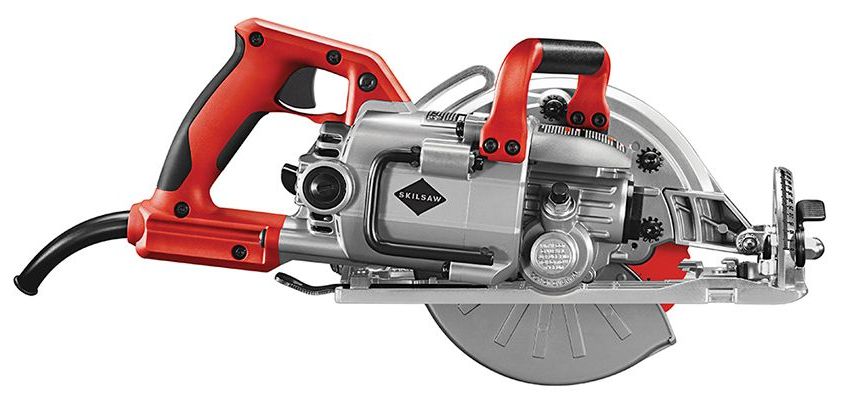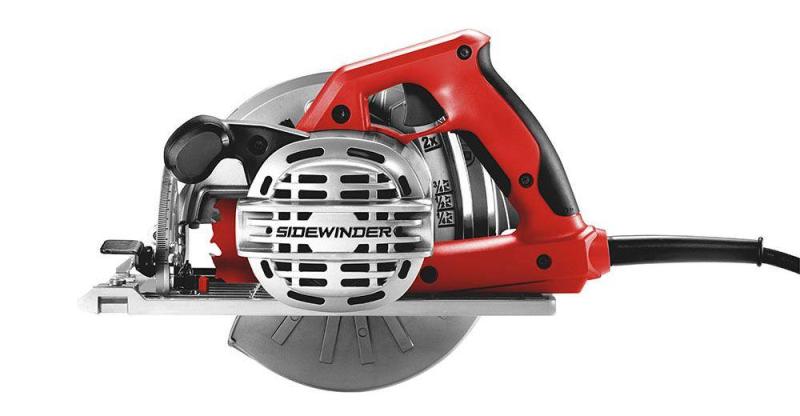When it comes to circular saws, what do you really know about them? Yes, it has a blade and yes, there are cordless and corded options available. But did you know that the way they work can be different? Some circular saws are Worm Driven while others are considered direct drivers or sidewinders. So today we are going to take a look at Worm Drive vs. Sidewinder. We will see what makes them different, why they share some of the same similarities, and which one is right for you?
Growing up my whole family was in the trades, my grandfather, my cousins, and eventually myself. So when it came to tools, I was pretty much always around them. However, it wasn’t until I was a little older that my grandfather gave me his circular saw. At the time, I just thought a saw was a saw and that was it. I remember him telling me it’s the best saw on the market, just make sure I oil it. There were two things that stood out to me about the saw.
The first thing was I remembered how heavy it was. I was just a skinny teenage kid and I felt like the saw weighed more than me. The other item I remember was being intimidated by the saw when I was using it which is not good when using power tools. The saw was extremely powerful and ripped through anything that got in its way.
It wasn’t until I was a little older that I realized what he gave me, it was a Skilsaw Worm Drive circular saw, considered the best saw in the business. In fact, it was the saw that built America. That was when I realized a saw isn’t just a saw, in fact, there were the two kinds, the Worm Drive and the Sidewinder.
Background
The circular saw can be traced back to 1777 and has gone through some extreme changes over the years and also has lead to other forms of tools that are based around the circular saw such as miter saws and table saw. However we are not here for a full history lesson but if you would like to read more, check out Wikipedia for more information. Since we are here regarding the Worm Drive and Sidewinder, it is helpful to understand some of the history.
The Worm Drive was the first portable circular saw that was invented. Edmond Michel invented the saw back in 1924 which later on became known as Skilsaw. So when you see Skilsaw and why they are number one with Worm Drives, now you know. They invented and perfected the saw. Shortly after, in 1928 Art Emmons invented the sidewinder version.
As you can see both the Worm Drive and Sidewinder have been out for a long time. Over the years, power tool companies have been able to reduce the size, increase the power and make the saw better for the consumer.
What is a Worm Drive and What is a Sidewinder?
Before we jump into the similarities, differences, advantages, and disadvantages, it’s helpful to understand how each tool works and what separates them into each category. The main difference between each saw is where the motor is placed on the tool and yes, it does make a difference where the motor is placed.
- Worm Drive – A Worm Drive saw has the motor behind the blade
- Sidewinder – A sidewinder or Direct Drive has the motor on the side of the blade
You wouldn’t think the motor placement has much to do with the saw but as we see below, a simple placement makes a world of difference how the saws perform and does change how the saws operate for the user.
What are the Similarities?
- Function – The biggest similarity is the function of the tool. Each tool has a motor that spins a blade which in return can cut wood, plastic, metal, cement and more. As we will see, each saw will excel at different types of cuts and different types of materials.
- Features – Both saws do feature the ability to change the depth of cut and make bevel cuts. Another similarity is that each saw can be purchased in a corded or cordless version.
While there are other small similarities, those are the major ones to point out. Overall, there are more differences than similarities.
What are the Differences?
While the function of both types of saws are the same, the saws actually have more differences than similarities.
- Motor Position – As we discussed above, a Worm Drive has the motor behind the blade (behind the center point of the blade). A Sidewinder has it inline with the center of the blade.
- Blade Position – Not always but usually the Worm Drive has the blade on the left while a Sidewinder has the blade on the right.
- Weight – Because of the way a Worm Drive works and how it engages the blade (non-parallel), it has a shaft with a spiral thread that engages a toothed wheel. All this makes it heavier than a Sidewinder. Typically a Worm Drive weighs about 11-15 lbs while a Sidewinder only weighs 6-9 lbs.
- Power, Speed & Torque – The true nature of a Worm Drive offers more torque than its counterpart, the Sidewinder. Since torque and speed have an inverse relationship, the Sidewinder will have a higher blade speed.
- Maintenance – Most Worm Drives require the user to add oil because Worm Drive requires lubrication. There are some Worm Drives that have closed systems and do not require the user to add lubricant. Sidewinders are closed systems and do not require the user to add any oil.
- Handle Position – While not always true, most Worm Drives have a rear handle while Sidewinders have a handle on the top of the saw. Recently some manufacturers have designed Sidewinders with handles on the rear of the tool.
Popularity
Depending on where you live in the United States, it might indicate the popularity of the saw. I have been told that the Worm Drive is extremely popular in the middle of the United States while the Sidewinder is more popular along the coasts. Now I am not sure if that is true, it’s just something I have heard over time.
However, if you are a contractor, especially a framer, you are more than likely going to be using a Worm Drive saw as you need that torque over speed. A homeowner or other contractors will most likely be using sidewinders because they care more about the weight and run time for cordless saws. For certain applications, a Worm Drive is overpowered and not needed, so why work with the extra weight.
Power vs Torque vs Speed
So when it comes to power, speed and torque, yes there is a difference between both types of saws. The one thing you have to remember there is an inverse correlation between speed and torque. The faster the blade spins, the less torque you have. The slower the blade spins, the more torque you can produce. The same holds true for drills and impacts and this is something manufacturers always have to weigh when designing and marketing power tools.
So with that said, a Worm Drive usually has more torque and the blade does spin at a lower rpm compared to a sidewinder. Again, I am saying usually. There are sidewinders that have high toque.
As time has moved on and technology and motors have become better, the difference isn’t as noticeable as it once was. You have to remember if you are going to buy a circular saw, do your research. Don’t just assume a Worm Drive will have more power and don’t assume all sidewinders have more speed.
You need to look at your application and match your saw to your use. In fact, they even have saws built for specific tasks like cutting concrete or cutting metal. So do your research.
Advantages
Worm Drive
When it comes to power and production, the Worm Drive is king. Go on any job site where they are framing and cutting 2×10″ or multiple sheets of plywood for decking and I am willing to bet they are using a Worm Drive saw. A Worm Drive is made for production. They don’t bog down and cut through anything without breaking a sweat.
Sidewinder
Sidewinder has a lot of advantages since they are lighter and less expensive (for the most part). Sidewinders excel at working overhead where weight is an issue. They are great for the homeowner who isn’t using the saw all the time and isn’t cutting through multiple sheets of plywood. A sidewinder is great for the contractor who isn’t only a framer and that isn’t their primary tool.
Disadvantages
Worm Drive
The biggest disadvantage is the weight of the tool and yes, they can cost more. There are a lot of times you don’t need all that power so why have the extra weight?
Sidewinder
The biggest disadvantage is the power aspect. If you need production and are cutting all day long and multiple types of material or multiple sheets of plywood, a sidewinder isn’t going to do the job efficiently.
Which Saw is Right for Me
As a user, you have to decide what you will be using the saw for. Use the information above and go from there. What tasks or projects are you going to be doing more? Are you a homeowner looking to cut some wood once in a while? If so, a sidewinder is a perfect solution. Are you getting into the trades and will be framing? If so, a Worm Drive might be up your alley.
Just make sure you do your research. Understand the difference between each tool. Once you understand the difference, look at different saws, and compare the specs to see which one suits you the best.
Bottom Line
As you can see, there are some big differences between a Worm Drive and Sidewinder. However, there are also a lot of similarities. As technology gets better, I only see these saws having more in common than features that are not in common.
As a consumer, the best action you can take is to understand each drive system, figure out what type of work you will be doing and find what suits you the best. Go to a local big box store and pick each saw up. Feel the difference, does weight matter, does blade placement matter, and do certain features matter to you?
Once you decide which drive system is best suited for you, do your research to see which circular saw is the best for your needs. There are a lot of different manufacturers that make circular saws. Don’t just settle and think all saws are the same because they are not.





does a worm drive have a deeper cut since the motor is out of the way?